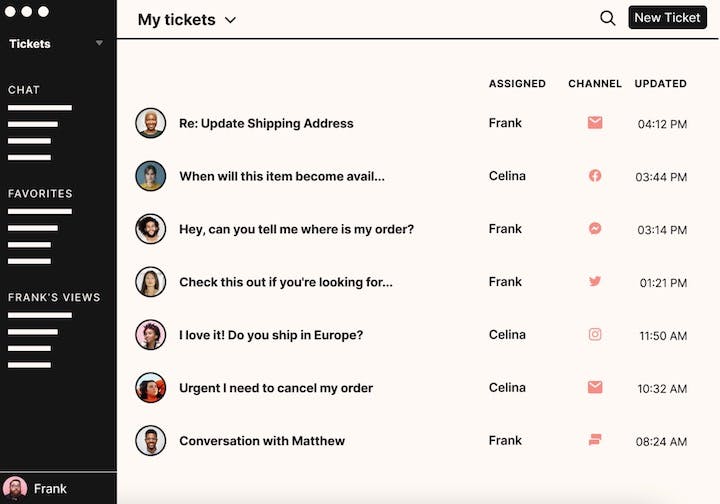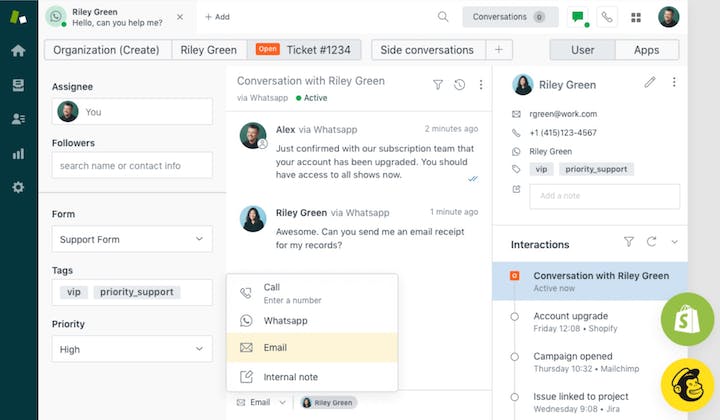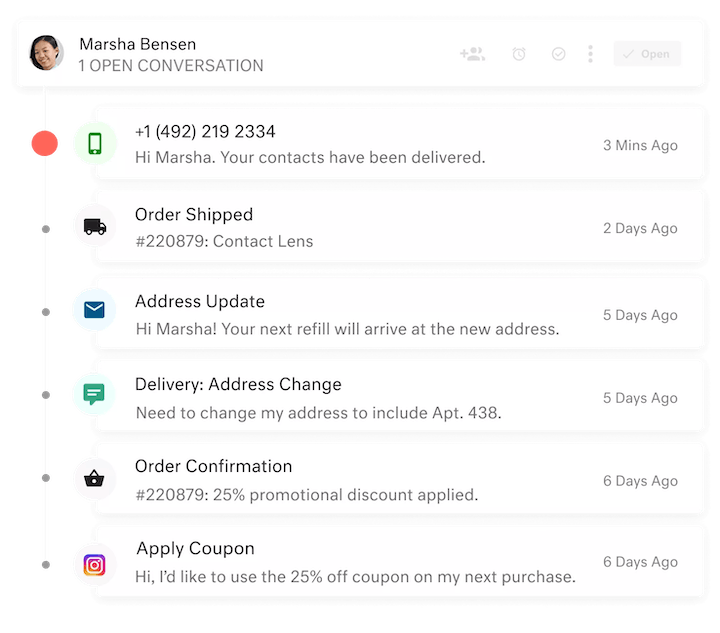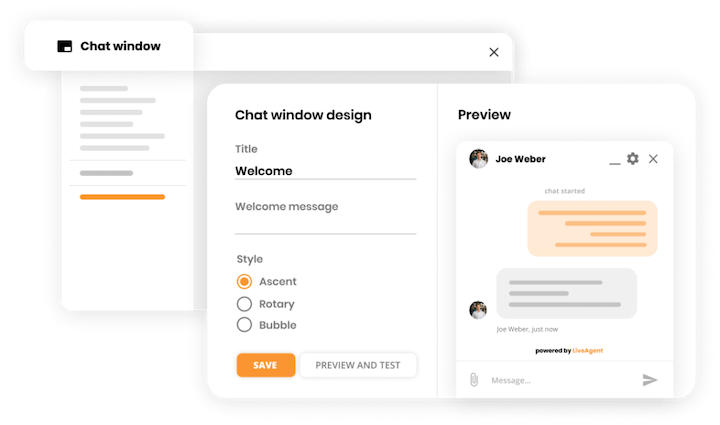The 8 Best Ecommerce Help Desks On The Market Today


If you sell a product or service online, it’s inevitable that your customers will have questions. Self-service tools like FAQ pages and instruction manuals help, but they probably won’t be able to cover every question that comes your way.
Since most ecommerce businesses don’t have physical locations, the only way customers can connect with you is through channels like email, chat, social sites, or over the phone. Managing all of that can get messy if you don’t have a dedicated tool.
Ecommerce help desk software is specifically built to help you and your team manage those requests, all while delivering a great customer experience.
What is ecommerce help desk software?
An ecommerce help desk is a customer contact platform for all your customer service. This might mean pulling in information from several sources:
Emails from your online store.
Messages from marketplaces like Amazon and eBay.
Requests from social media platforms like Facebook or Instagram.
Phone call logs.
Live chats.
You can help all your customers from the same browser window, and all support records end up in the same place.
Help desks also come with tools to make support easier. For example, you can create a library of saved replies so you don’t have to write the same answer 20 times a day.
Does your ecommerce business need a help desk?
Not every ecommerce business needs help desk software. It’s rarely free, it takes time to set up, and it forces teams to change how they work. Sometimes it isn’t worth the resources it uses.
But only sometimes.
In most cases, a help desk will save time, money, and keyboard-sore fingers. Whether it will do that for you depends on the way your team serves its customers.
Read through the benefits below to see how an ecommerce help desk can help your business.
Make multichannel support easier
How many support channels do you use? Definitely email, right? How about eBay messaging? Amazon messaging? Chat? Others?
If you’re dealing with more than one, you’re providing multichannel support. Almost every ecommerce business does. Since different channels have different interfaces, passwords, sets of tools, and message archives, they tend to get isolated from the rest of the business.
Siloing each channel like this can cause huge problems:
Inconsistent support across different channels.
Difficulty prioritizing requests.
The need to create and maintain redundant systems.
Trouble collecting and analyzing support data.
Longer training times for employees who serve multiple channels.
Slow responses as agents switch from screen to screen and back again.
A help desk puts everything in one place and eliminates all the issues above. Most help desks support email by default and can pull in other channels with the help of upgrades and apps.
When you can go from flipping through browser tabs all day to answering everything on a single screen, it’s magic.
Save time on replies
Take a look at the support tools you use right now. Do they make it possible to meet response time expectations? If not, could you make better use of them?
Take Amazon as an example. Their email templates let you save answers to common questions and enter them with two clicks, much like saved replies in a help desk. Are you taking advantage of tools like these, or are they getting ignored?
A few hours learning and setting up the tools available to you might turn into that much time saved every week.
When you understand what you already have, check whether a help desk would be a step up. Most will let you:
Create saved replies (also known as email templates or prepared responses).
Set up automatic responses, reminders, and notifications.
Assign conversations to specific agents.
Organize and prioritize customer interactions.
Automate repetitive management tasks with tools like workflows
Few other support systems offer so many time-saving features. In addition, help desks make these tools available across all of your supported channels, not just one.
Would these make customer service easier for your team, or do you already have all the tools you need to reply as fast as possible?
Identify who helped which customer
Have you ever looked at a teammate’s response and wondered, “Who wrote this?”
Maybe the responder was less than professional. Maybe the author had some information that you don’t, and you’d like to pick their brain.
Whatever the case, you need to know who sent that message, but there’s no way to tell.
Some support systems (like eBay’s) don’t track who wrote which response. Agents can always write in a signature, but that slows them down and invites inconsistencies.
Help desks provide separate accounts for everyone on your team, logging who wrote which reply and when. They also make it easy to view all of a given agent’s responses, so there’s no more guessing.
Keep support records organized
Collecting data points on support can feel like chasing marbles down a hill. Every time you pick one up, others roll further away as more requests come bowling in. If you’re dealing with multichannel support, it gets even worse as they bounce down side roads and skitter into the bushes.
You may keep up using a spreadsheet for a while, but that very quickly becomes unsustainable.
Here are some signs your team may be chasing too many marbles:
A customer writes in about a prior request, but agents can’t locate it and have to ask the customer to re-explain the situation.
Team members often ask each other for info they can’t find on their own.
Large-scale problems go unrecognized for too long because patterns are hard to identify.
When the support manager is asked to provide a statistic, they have no information.
You might have less trouble if you only provide support from one email address. However, if you have messages in multiple systems, you’ll be rolling down that hill like Princess Buttercup.
Help desks put all your marbles in a nice, level box so they can’t roll away from you. With all your customer service in one place, all your records are in one place as well.
Most help desks will even sort your data points with deep search options. They make it easy to find every message from a given person, whether that person is an agent or a customer. More advanced features like custom fields allow you to track details unique to your business, such as SKUs or shipment tracking IDs.
Do whatever it takes to avoid losing your marbles.
Make important decisions using accurate data
OK, so you’ve collected your basic info. You have your marbles. Now what? Does that data mean anything, or are you going to have to spend some quality time with Excel and PowerPoint?
Help desk reporting tools can gather info and crunch numbers fast. Some can show details like your busiest times and days, average first reply times, and customer satisfaction statistics.
This actionable data powers smart decisions. You’ll know when your customers need you most, where there’s room for improvement, and whether new strategies are working. If you’re sick of making decisions in the dark or spending hours in spreadsheets, a help desk will help.
The 8 best ecommerce help desk tools
If after reading the information above, you decided your business could benefit from a help desk, start your shortlist of options to consider with the eight great ecommerce help desk tools below.
Help Scout
Zoho Desk
Freshdesk
Gorgias
Zendesk
HubSpot Service Hub
Kustomer
LiveAgent
1. Help Scout
Best for growing teams focused on customer support.
Help Scout is a complete customer support platform dedicated to helping growing teams deliver exceptional customer service. When you sign up, you get access to an entire suite of customer support tools.
Help Scout’s shared inbox tool makes managing customer conversations hassle-free across multiple channels like email, live chat, and Facebook Messenger. You can automate routine tasks like ticket sorting using workflows and add additional context to conversations using notes. With saved replies, you’re able to answer routine requests quickly.
You’re also able to empower customers to find answers on their own with Docs and Beacon. Docs is knowledge base software that lets you create, organize, and manage support-related content. The intuitive WYSIWYG editor makes content creation quick and easy, and the built-in search capabilities ensure customers can find the information they need.
With Beacon, you’re able to deliver help content wherever your customers are through an embeddable widget. Customers can search your help documentation directly from your website or from within your app, and you can even set suggested articles for each individual page. If they’re not able to find what they need, they can submit a request to your support team from the widget, too.
Beacon also makes it easy to communicate with your customers proactively. Surface a message or microsurvey from any Beacon to alert customers about an upcoming sale or collect real time feedback as they shop.
More specifically for ecommerce teams, Help Scout also offers integrations for Shopify, WooCommerce, and Magento, letting you see things like order history to streamline customer interactions. If you use another platform, you can always create a custom integration using the API.
Best of all, you can set up Help Scout in a matter of hours and be a power user by the end of week one. You also get access to world-class 24/6 support if any questions come up during your set up. It’s everything any ecommerce team needs to deliver outstanding customer support.
Price: Free trial available. Plans start at $20/user per month.
Try the customer support platform your team and customers will love
Teams using Help Scout are set up in minutes, twice as productive, and save up to 80% in annual support costs. Start a free trial to see what it can do for you.
Try for free
2. Zoho Desk
Best for teams using another Zoho product.

Zoho is most known for their CRM tool, but they have actually had a help desk solution for years called Zoho Desk. It includes some of the common tools you’d expect to see like a shared inbox tool, a knowledge base builder, and options to do live chat support.
You’re able to automate certain routine tasks, and their AI product, Zia, can reduce ticket volume for agents (though it’s only offered on their highest-cost plan). On the ecommerce side of things, you’re able to connect to Shopify and some other online marketplaces through third-party integrations.
If you’re using Zoho CRM, you’re able to seamlessly connect customer profiles to your help desk software, which can provide additional context to customer conversations. We should note, some basic features like collision detection are limited to higher-cost plans. You also have limited access to Zoho’s support team, unless you’re on a higher-tier plan.
Price: Free trial available. Plans start at $14/user per month.
3. Freshdesk
Best for teams doing phone support.

Freshdesk is a customer support platform that includes a number of different customer service tools. There’s a shared inbox, a knowledge base builder, live chat software, and even AI-powered automations you can utilize.
Where Freshdesk really shines is phone support. They have advanced phone management features and include minutes on all of their omnichannel plans. It’s something to keep in mind if your team communicates with customers over the phone regularly.
On the ecommerce front, Freshdesk has a Shopify app that lets you see order history, provide refunds, and cancel orders directly from their tool. They also have integrations for other ecommerce platforms in their marketplace, though they aren’t as robust.
Price: Free trial and plan available. Paid plans start at $15/agent per month.
4. Gorgias
Best for Shopify-based businesses.

Gorgias is a help desk solution with a heavy focus on ecommerce use cases. When you sign up, you get access to a shared inbox tool, which supports a number of channels including email, Facebook, and Instagram. You also get access to a live chat tool.
Gorgias also offers Shopify, BigCommerce, and Magento integrations (though Magento and BigCommerce are only available on the higher-cost plans). After setting them up, you’re able to see, edit, and even refund orders directly from the help desk application, saving your team lots of time.
Still, their pricing structure may be a concern for some teams. It's based on volume, meaning your costs could vary month to month, which may be difficult for some teams to stomach.
Price: Free trial available. Plans start at $10 per month (includes 3 user seats and 50 billable tickets).
5. Zendesk
Best for enterprise companies.

If you’ve done any amount of looking for customer service software, chances are you’ve come across Zendesk. They offer a customer support platform that has all the usual suspects like a shared inbox, a live chat tool, a knowledge base builder, and even proactive support options through automated messages.
With Zendesk you also get access to a number of collaboration tools like internal notes and collision detection. You can improve productivity by automating routine tasks and can even go a step further by utilizing Zendesk’s AI tool (though it is limited to their higher-cost plans and there are limits on replies).
You can also connect to most ecommerce sites through third-party integrations in Zendesk’s Marketplace. Honestly, there’s not a lot Zendesk doesn’t do. That said, many users report there are often additional setup costs beyond the base price and getting the software fully set up can take upwards of three months.
Price: Free trial available. Plans start at $19/agent per month.
6. HubSpot Service Hub
Best for teams using HubSpot.

Many people mainly think of HubSpot for their sales and marketing products, but in the past few years they’ve also started offering support solutions in the form of their Service Hub product. HubSpot Service Hub includes customer support tools like a shared inbox, a knowledge base builder (only included on their higher-tier plans), and live chat software.
If you’re using another HubSpot product, they integrate seamlessly, so if you have a contact in HubSpot’s sales tool, all their information is instantly accessible to you in Service Hub without any additional setup needed.
On the ecommerce front, Service Hub has a number of ecommerce integrations like Shopify, BigCommerce, and Magento. That said, they are all third-party integrations and there are multiple ones for each shop, so it might take some trial and error to see which ones work best.
Price: Starting at $45 per month (two users included).
7. Kustomer
Best for teams with high volumes of basic requests.

Kustomer is a self-described customer service CRM platform. The software includes customer service tools like a chat tool, a shared inbox, and some self-service options. There are also bulk email capabilities, so you could use Kustomer for one-to-many communication, which can be good for things like product launches or updates (though it is an additional cost).
Along with CRM capabilities, Kustomer’s claim to fame comes in the form of their AI product called Kustomer IQ. With it you’re able to automate a number of different things like conversation sorting and replies to basic questions, both of which save your team time and energy.
Kustomer also has integrations with popular online marketplaces like Shopify, Magento, and BigCommerce. Though an impressive tool, it does come with some variable costs, which could be a stumbling block for more budget-conscious teams.
Price: Free trial available. Plans start at $29/user per month.
8. LiveAgent
Best for teams covering many channels.

LiveAgent is a customer support tool that lets agents respond to requests through a variety of different channels. Whether it’s an email, a message from a social site like Facebook, Instagram, or Twitter, or a real-time chat conversation, LiveAgent has it covered.
If you are looking to provide social support or live chat, those are only offered on LiveAgent’s higher-cost plans. You can add social channels on the base plan, but you do pay per account, which could get expensive.
They also boast a large amount of integrations including Shopify, Magento, and Squarespace, giving it some extra points for ecommerce teams.
Price: Free trial and plan available. Paid plans start at $9/agent per month.
Choosing a help desk
There are many available options on the market to help ecommerce teams deliver standout customer support. Though there are many similarities, there are also a lot of nuances between options.
Nothing can take the place of firsthand experience, so make sure you get a demo or a free trial with any option you’re seriously considering, and have multiple people on your team try out the tool. There are a number of different stakeholders on any support team, and whatever solution you pick needs to work for everyone involved.
Finally, if you’re struggling to get budget approval for a new tool, our guide to Measuring Customer Service ROI may give you some ways to better convince your leadership team to make the investment.
—
This article was compiled from an original piece by Justin Golschneider, Product Manager for ChannelReply, and additional writing from Jesse Short at Help Scout.
The Supportive Weekly: A newsletter for people who want to deliver exceptional customer service.







